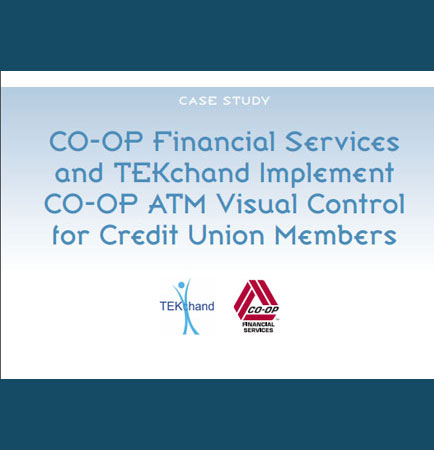
PROCESSING. PLEASE WAIT...



White Paper: TEKchand
While large financial institutions have the resources and IT departments to develop their own ATM technology path, many smaller-to-midsized credit unions and financial institutions depend on their transaction processor or ATM hardware manufacturer to deliver new ATM products and functionalities.
After many trials and tribulations, change is finally entering the ATM channel to make life easier for ATM owners. Using a combination of vision, planning and dedication to detail, CO-OP Financial Services and TEKchand are working to make what was once a static cash-dispensing box, into a powerful and dynamic marketing communication vehicle.
By: TEKchand
To be best in class, an effective ATM remote management system has to clear various significant hurdles. While there are many ATM remote management solutions, very less offer the completeness, robust applications, ease of use, ATM-centric expertise and affordability of CO-OP ATM Visual Control. ATMs have always remained a significant piece of a credit union’s functionality, and play an essential role in offering convenience to members. This whitepaper highlights the importance of moving to true ATM Remote Management, ATM as a valuable asset to the credit union branch model and also explains the efficient management of the ATM fleet as a necessary duty. It discusses: Concept of CO-OP ATM Visual Control Three critical applications delivered by CO-OP ATM Visual Control Features and functionality for credit unions delivered by Remote Manager
By: Duco
One of the main criticisms of the original MiFID was that national regulators did not enforce the directive with the same zeal across Europe. The list of financial instruments covered has been extended to almost all instruments traded in European markets – with particular emphasis on the OTC derivatives market that was previously out of scope for MiFID I. The issue with making this distinction across so many different instruments is one of the main reasons why the MiFID II and MiFIR implementation date has been delayed twice from its original start date of January 2015. While regulators have not specifically outlawed the use of spreadsheets and UDAs, it is commonly accepted that under MiFID II, organizations need a much more robust and scalable approach to data control. What are the data problems that MiFIR transaction reporting requirements are likely to cause? What is the impact of the new regulations on firms? What is the cost of non-compliance? Move ahead and read the following whitepaper that will address all your questions, including these: How to identify traders or algorithms involved in the decision and execution process of a transaction? Which general fields will require extra reconciliation steps? What are the number of data fields required on transaction reports and the reporting requirements? How to trade instruments on an approved venue? Which legacy systems can be replaced and which ones are difficult to scale?
By: Duco
Data risk is an increasing challenge in the financial industry, for the innumerable processes that need to be taken care, before reporting the data to the regulators. It is extremely important to stay complaint and...


 2025 All Rights Reserved | by: www.ciowhitepapersreview.com
2025 All Rights Reserved | by: www.ciowhitepapersreview.com